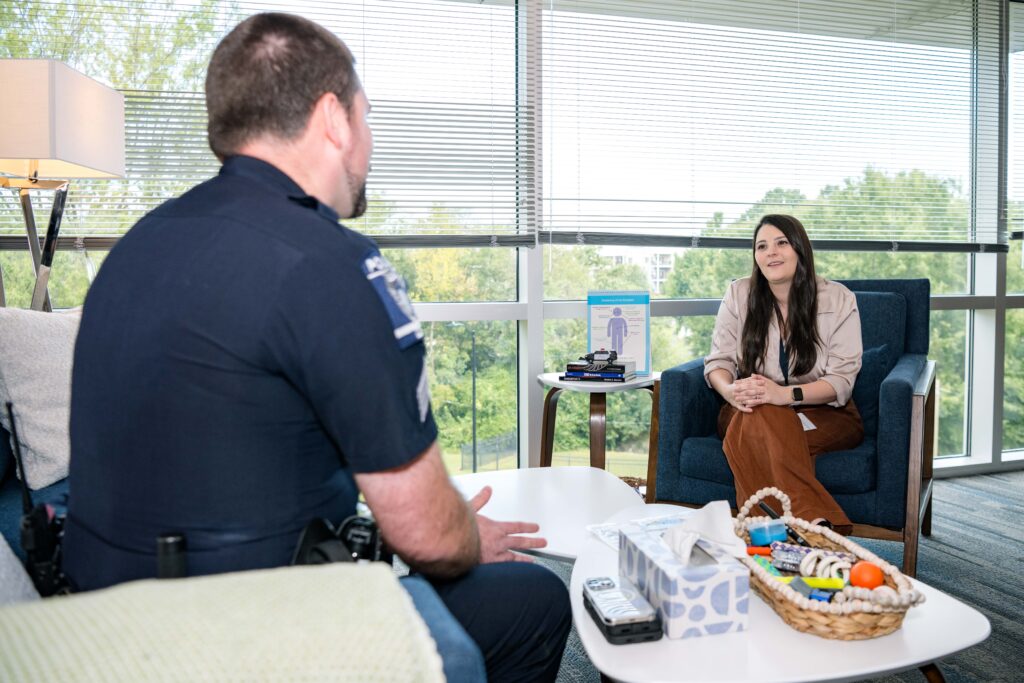Summer 2025
From crisis to culture shift

In the aftermath of a devastating ambush on April 29, 2024, where four law enforcement officers were killed while serving felony warrants, the Charlotte-Mecklenburg Police Department (CMPD) faced a pivotal moment. The attack sent shockwaves throughout the department and wider Charlotte community, but it also underscored the urgent need for sustainable, proactive mental health support for law enforcement professionals.
CMPD responded with purpose. Through a fortified Office of Employee Wellness and the rollout of the Clinical Care Access Program (CCAP), the department has prioritized emotional resilience and psychological safety for its more than 3,000 sworn and civilian employees.
Scaling up wellness: A strategy tested by tragedy
Deputy Chief Zeru Chickoree, a 27-year veteran of CMPD, said that while wellness efforts were already underway, the events of April 29 acted as a “proof of concept” for how vital and scalable those efforts needed to be.
“We had just gotten out of our wellness meeting on April 29th, where we had recapped what we had put together in the previous six months,” Chickoree recalled. “We were able to mobilize everything that we had basically put together.”
Ashley Higgins, a licensed mental health counselor and Senior Behavioral Health Specialist with CMPD, explained, “April 29th really was proof of concept. These things were working, and maybe we need them to be bigger.” CMPD quickly expanded peer support, increased clinical staff, and boosted program frequency to meet rising demand for mental health services.
A groundbreaking reimbursement program
At the center of CMPD’s modern approach is CCAP, a mental health reimbursement program launched in February 2024. The initiative reimburses up to $2,600 annually for outpatient therapy and $6,000 for inpatient care per employee. The goal? Remove financial barriers and normalize help-seeking.

“We give our employees the ability to, once they’ve seen a therapist, bring the receipt to us… and we are able to reimburse them for any out-of-pocket expenses,” Higgins explained.
Since its inception, CCAP has reimbursed approximately $80,000 in therapy costs — a number that signals both need and engagement. “That’s significant,” Higgins said. “We know that’s being utilized.”
The response to CCAP has been so overwhelmingly positive that the Charlotte-Mecklenburg Police Foundation doubled its initial support, now funding the program with $200,000 total. “This is life-saving money,” Higgins emphasized, noting that anonymous feedback included individuals crediting CCAP with giving them a second chance at life.
Normalizing mental health in police culture
Chickoree and Higgins both agreed that one of the greatest wins was a culture shift — one where seeking help is no longer seen as a weakness. “You would never hear a sergeant talking about getting mental health treatment,” said Chickoree. “And it’s so much more normal now… from lieutenants to captains.”
He added that as a young officer and academy instructor, he often shared openly about his own experiences in therapy. “It helped me become a better negotiator,” he said, referencing his time on CMPD’s hostage negotiation team.
“Self-care is not just for the weak,” Higgins noted. “It is for the people who remain strong.” She emphasized that resiliency starts with intentionality: maintaining hobbies, social connections, and prioritizing mental health outside of work. “The job kind of takes over,” she said. “Folks lose those things that make them them.”
Rapid response and community partnership
In the days following the April 29 ambush, CMPD activated a broad network of support. “We conducted these large-scale debriefs… to normalize the idea of talking about critical incident stress,” Chickoree said. The department partnered with external groups like the Billy Graham Rapid Response Team, Responder Assistance Initiative, and NC LEAP to provide daily rotations of peer support, chaplains, and clinicians in four heavily affected divisions.
“These were people helping out of the goodness of their hearts,” said Higgins. “If you are in the wellness field, know your resources, have those people in your phone ahead of time.”
CMPD also utilized Bank of America Stadium as a neutral, supportive venue for one of its largest debriefing sessions. “Those immediate things helped segue into smaller group sessions,” Chickoree said.
Measuring the impact
CMPD’s wellness programs have had tangible effects. “We were very fortunate last year,” Chickoree said. “The number of people who resigned was a lot lower than it had been.” The department also stemmed attrition among recruits. “We didn’t have a huge hemorrhage,” Higgins noted.
CMPD measures success not only in retention but also through employee feedback and continued program engagement. “The feedback has been so positive,” said Higgins. “People continue to utilize us.”
» ALSO SEE: Footwork and agility training for the tactical athlete
The Office of Wellness logged more than 3,300 employee contacts, 144 outreach events, and 14 critical incident stress management debriefs in 2024 alone.
A blueprint for other agencies
Chickoree believes that other departments can replicate CMPD’s model with the right support. “If other agencies have a foundation, speak to them,” he advised. “And if not, find business leaders who want to invest in their community’s safety.”
Both leaders agreed that the message is simple: mental wellness is a critical infrastructure in modern policing. “We are all people at the end of the day,” Chickoree said. “We deserve to have a happy, full, and productive life. One of the best ways to do that is to get therapy — to work out the issues we all carry.”



